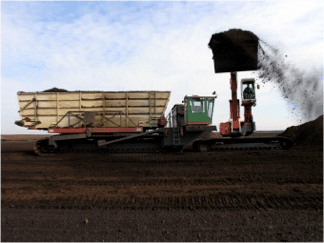There’s peat and peat: how white and black types differ
Our raw materials
Contrary to popular perception, not all peats are created equal. There are different kinds – raised-bog peats alone include a range of grades, from white peat to black peat. Common to all is that they are accumulations of vegetable matter in boglands; both white and black peat are the dead remains of plants found in raised bogs. If the levels of organic matter – i.e. the residues of plants – in these deposits are below 30%, then the term used is ‘half-bog’. Only when the 30% mark is exceeded do we speak of peatlands and true peat. So what is the difference between the various types of raised-bog peat? The criteria involved are closely linked and include:
- the degree of degradation of the organic matter;
- the structure of the plant remains;
- the colour of the peat;
- the age of the deposit;
- the peat’s degree of compaction;
- which of the deposited layers it is obtained from;
- the means of extraction;
- the physical properties.
For one thing, white peat is not white in colour but yellow-brown. The decomposition of vegetable matter is not particularly advanced, and the plant residues are still clearly visible. White peat forms the uppermost layer of the bog and is, therefore, exposed to only very low pressure, so that the degree of compaction is small. This peat, which (geologically speaking) has been deposited most recently, is obtained using a variety of techniques. For example, the method used by Klasmann-Deilmann is that of sod-cut peat and surface-milled peat extraction. The white peat is then fractioned using modern star screens into different particle sizes ranging from very fine to coarse.
White peat is, like black peat, characterised by a low pH value of between around 3.0 and 4.0, as well as excellent water and air storage. White peat is one of the most important substrate constituents in commercial horticulture.
Black peat is the deepest and oldest layer in peat bogs. Over the centuries, the considerable pressure exerted by the upper layers leads to a high degree of compaction, with black peat appreciably more compact than the looser white peat. The vegetable remains are barely recognisable as such, as degradation is far more advanced than in the upper peat layers. Black peat is extracted in spring or summer and must be laid out to dry in thin layers prior to harvesting.
Black peat is also an important raw material for growing media. In order that its outstanding properties, including its minimal shrinkage, consistently high water capacity and optimum air capacity are fully realised, it needs to be frozen right through.
